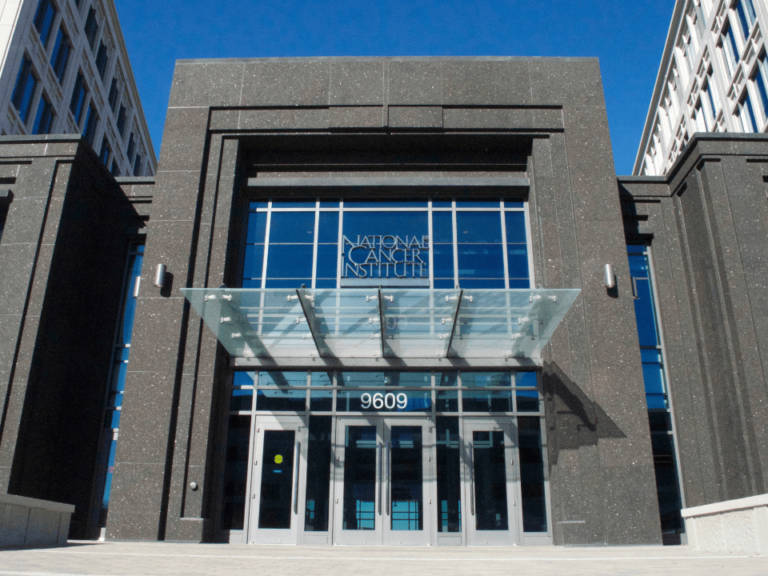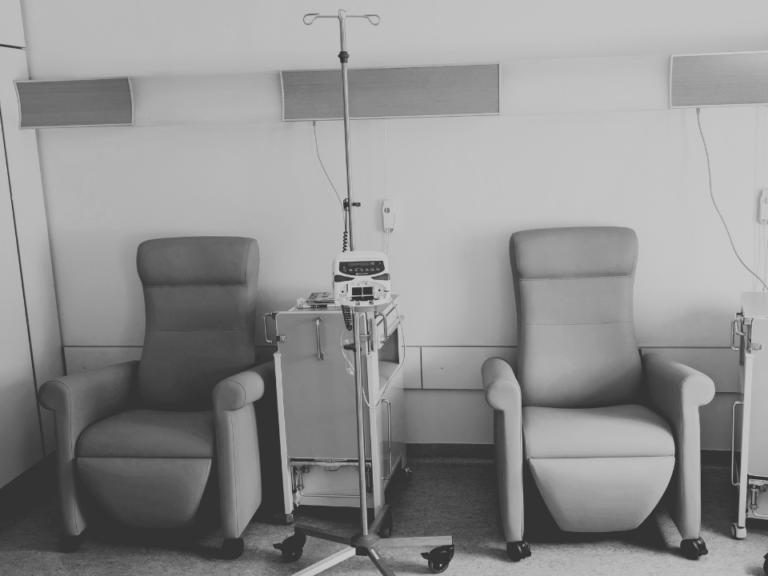

Since early May, a group of current and former NIH employees have gathered every Saturday at the Medical Center Metro station in Bethesda, MD, to mourn what they describe as the loss of scientific progress under the Trump administration.
“Mourn” is precisely the word to describe these gatherings—by intent.
Dressed in black, some with veils or masks obscuring their faces, the demonstrators carry signs bearing messages like “RIP Future Scientists,” “RIP Future Cures,” and “Rest in Power DEI,” a somber tribute to what they see as a fading commitment to science and inclusion.
Many demonstrators have taken the death theme to the next level, propping up skeletons à la Halloween and Día de los Muertos.
Since January, the Trump administration has made aggressive cuts to funding for research at NIH. Approximately 1,300 NIH employees have been fired as part of the Department of Government Efficiency’s initiative to reduce “fraud” and “waste.”
The administration’s budget request for fiscal year 2026 proposes to award 15,000 fewer research grants, cap indirect costs at 15%, and consolidate the existing 27 institutes and centers into eight (The Cancer Letter, June 20, May 2, Feb. 10, 2025).
A story about the administration’s FY26 “One Big Beautiful Bill” is available on page X / in this issue.
On June 23, over 300 current and former NIH employees, as well as 24 Nobel laureates, signed the Bethesda Declaration, a document protesting what they called the politicization of science and research funding under the Trump administration (The Cancer Letter, June 13, 2025).
“It did start out as kind of a funeral, and it has evolved over time,” a current NIH staff member involved with planning the vigils told The Cancer Letter.
The NIH staff member spoke with this reporter on the condition of anonymity.




Source: NIH vigil organizer
After the Bethesda Declaration was published and publicly signed, the tenor of the vigils changed, the NIH staff member said: “The bravery trajectory at NIH has been quite the curve. So, [some] people have shed the veils and the masks.”
The vigils initially began with a rogue “take your child to work” day, replacing an official NIH one which was canceled, the NIH staff member said.
“We were in the mode of trying to figure out what we wanted to do in order to express dissent to everything that was happening at NIH,” the NIH staff member said. “Federal workers needed some assistance within the bravery department when it comes to voicing dissent, and early in the process, we were easing ourselves into it.”
The NIH staff member said the first event was a good jumping off point, because it felt a little more “educational,” and not so much “resisting the administration.”
“The vigils are kind of complementary to that—they’re a way to more clearly express dissent,” the NIH staff member said. “We wanted to make it a vigil because we are in mourning due to all of the cuts and cancellations and the programs lost. We wanted to frame it as a way for the NIH community to come together and have feelings about everything that was happening, and also express dissent as a form of protest.”


The theme of the vigils varies week to week. The most recent one, on June 29, commemorated losses to the LGBTQ community because it was the last Saturday of Pride month. There are plans for future vigils that will center on different religious traditions, the NIH staff member said.
“There are some Jewish NIHers who want to address the cuts to Harvard and Columbia under the ruse of antisemitism,” the NIH staff member said, “and how these cuts are harming Jewish communities because there are a number of genetic diseases that disproportionately affect Jewish communities that are no longer being researched.”
The NIHers plan to incorporate some Jewish funeral traditions into a future vigil.
The structure of the vigils functions similiarly to a memorial service or funeral.
“Typically, what we do is we’ll have like a half-an-hour where whoever is emceeing will have some opening words, maybe talking a bit about what happened that week, anything in particular that’s notable. Then, depending on the theme, other people may have prepared words that they want to say. And then we may open it up to just general attendees to come up and talk about anything that they want to talk about. Just like a funeral really.”
The vigils end with a joint renewal and recitation of the oath of office before the group, carrying signs, moves toward Wisconsin Avenue to garner attention from passing motorists.




The vigils are coordinated by the account “NIH Vigils” on the social media platform BlueSky. The account is moderated by former and current NIH staff members and, along with organizing the vigils, compiles weekly news related to cuts and losses.
The pinned message on the account reads:
Had a great time last weekend at a No Kings rally? Well, every Saturday is your lucky day!
Join current and fired NIH staff as they protest the cuts to funding, programs, and people!
Learn what new shit happened this week and what we’re doing about it.
Then wave signs at honking cars. It’s fun!
“We commemorate and mourn the losses resulting from cuts to funding, programs, and people that have been both discriminatory and indiscriminate,” reads the bio on the account.
BlueSky, an indepdendent social media platform, has become the clubhouse of an HHS resistance movement since Trump’s inauguration, creating an alternative and mostly anonymous social media presence to combat misinformation (The Cancer Letter, June 6, 2025).
The official Alt NIH account, for example, has nearly 50,000 followers, and is run by former RIFed or retired NIH employees. There is also an Alt CDC, and an Alt NCI, among others.
“The resistance is multifaceted,” the NIH staff member said of the other BlueSky accounts.
The vigils will continue for as long as NIH suffers disruptions to research and discovery, the NIH staff member said.
“And they will continue until NIH has been made whole again. So, that could be quite some time.”








